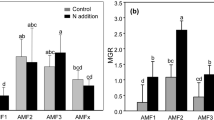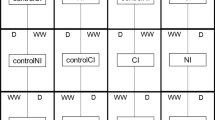Abstract
The rhizosphere microbial community is a complex of organisms interconnecting in multifold ways, acting upon each other and reacting to the surrounding environment. In the present research, we evaluated the influence of dual inoculation with arbuscular mycorrhizal fungi (AMF) and microalgae (Scenedesmus incrassatulus R83 and Synechocystis sp. R10) on basil plants performance. Different modes of basil inoculation (AMF, microalgae and a combination of both) were analyzed. We characterized AMF function (colonization and glomalin-related soil proteins), acid phosphatase activity (in root and soil), plant growth, photosynthetic parameters, secondary metabolites (fluorescence indices of leaf chlorophyll content; flavonols contents; nitrogen balance index), and the activity of plant enzymes linking nitrogen and carbon metabolism (glutamate synthase, aspartate aminotransferase and NADP-malic enzyme). The highest values of biometrical data were as a result of mycorrhiza application alone and in the mixed treatments with both microalgae strains. Dual inoculation with both microalgae and AMF, stimulated mycorrhizal function (concentration of glomalin-related proteins). Indexes of secondary metabolites (flavonols and anthocyanins) increased after treatment with Scenedesmus (Al1 and AM + Al1) compared to control plants. The addition of Synechocystis alone and in combination with fungi positively influenced nitrogen balance index. Different modes of inoculation increased gas-exchange parameters in all variations of inoculations compare to control plants. The results for activities of nitrogen-carbon metabolizing enzymes demonstrated close relationships with the plant growth. The mycorrhizal root colonization of basil may bear considerable economic importance. Thus, the addition of suitable AMF to the rhizosphere would significantly improve the growth and productivity of commercial Ocimum spp. cultivation.
Zusammenfassung
Die Mikrobengemeinschaft im Wurzelraum ist ein Komplex aus Organismen, die auf verschiedenste Weise miteinander verbunden sind, miteinander in Wechselwirkung stehen und auf ihre Umgebung reagieren. In der vorliegenden Studie wurde der Einfluss der Doppelinokulation mit Arbuskulären Mykorrhizapilzen (AMF) und Mikroalgen (Scenedesmus incrassatulus R83 und Synechocystis sp. R10) auf die Leistung von Basilikumpflanzen untersucht. Unterschiedliche Arten der Inokulation von Basilikum (AMF, Mikroalgen sowie eine Kombination aus beiden) wurden analysiert. Charakterisiert wurden die Funktion von AMF (Kolonisierung und Glomalin-verwandte Bodenproteine), die Aktivität saurer Phosphatase (in Wurzeln und im Boden), das Pflanzenwachstum, Photosyntheseparameter, sekundäre Metaboliten (Fluoreszenznachweis des Chlorophyllgehalts der Blätter, Flavonolgehalt, Stickstoffbilanz-Index) sowie die Aktivität von Pflanzenenzymen in der Verbindung des Stickstoff- und des Kohlenstoffmetabolismus (Glutamatsynthase, Aspartat-Aminotransferase und NADP-abhängiges Malatenzym). Die höchsten Werte dieser biometrischen Daten resultierten aus der Anwendung von Mykorrhiza allein sowie aus der gemischten Behandlung mit beiden Mikroalgenstämmen. Die doppelte Inokulation mit beiden Mikroalgen und AMF stimulierte die Mykorrhizafunktion (Konzentration Glomalin-verwandter Proteine). Die Indizes sekundärer Metaboliten (Flavonole und Anthocyane) stiegen nach der Behandlung mit Scenedesmus (Al1 und AM + Al1) im Vergleich mit Kontrollpflanzen. Die Zugabe von Synechocystis allein und in Kombination mit Pilzen hatte einen positiven Einfluss auf den Stickstoffbilanz-Index. Unterschiedliche Arten der Inokulation erhöhten Gasaustauschparameter in allen Variationen im Vergleich zu den Kontrollpflanzen. Die Ergebnisse zur Aktivität von Stickstoff-Kohlenstoff metabolisierenden Enzymen zeigten einen engen Zusammenhang mit dem Pflanzenwachstum. Die Wurzelbesiedelung von Basilikum mit Mykorrhiza könnte von beträchtlicher wirtschaftlicher Bedeutung sein. So würde die Zugabe geeigneter AMF in den Wurzelraum signifikant das Wachstum und die Produktivität im kommerziellen Anbau von Ocimum spp. verbessern.


Similar content being viewed by others
References
Van Aarle I, Olsson P, Söderström B (2002) Arbuscular mycorrhizal fungi respond to the substrate pH of their extraradical mycelium by altered growth and root colonization. New Phytol 155:173–182
Abd-Alla MH (1994) Use of organic phosphorus by Rhizobium leguminosarum biovar Viceae phosphatases. Biol Fertil Soils 18:216–218
Abdel-Raouf N, Al-Homaidan AA, Ibraheem IBM (2012) Agricultural importance of algae. Afr J Biotechnol 11:11648–11658
Aiba S, Ogawa T (1977) Assessment of growth yield of a blue-green alga: Spirulina platensis in axenic and continuous culture. J Gen Microbiol 102:179–182
Bradford M (1976) A rapid and sensitive method for the quantification of micrograms quantities of protein utilising the principle of protein-dye binding. Anal Biochem 72:248–254
Brilli F, Tsonev T, Mahmood T, Velikova V, Loreto F, Centritto M (2013) Ultradian variation of isoprene emission, photosynthesis, mesophyll conductance and optimum temperature sensitivity for isoprene emission in water-stressed Eucalyptus citriodora saplings. J Exp Bot 64:519–528
El Gamal M, Massoud O, Salem O (2009) The promotive effect of algae and Rhizobium leguminosarum on arbuscular mycorrhizal fungi activity and their impact on faba bean plant. Egypt J Microbiol 24:95–108
El-Khateeb MA, El-Leithy AS, Aljemaa BA (2011) Effect of mycorrhizal fungi inoculation and humic acid on vegetative growth and chemical composition of Acacia saligna labill. seedlings under different irrigation intervals. J Hortic Sci Ornam Plants 3:283–289
Fitter A, Garbaye J (1994) Interactions between mycorrhizal fungi and other soil organisms. Plant Soil 159:123–132
Georgiev D, Dilov H, Avramova S (1978) Millieu nutritif tamponne et méthode de culture intensive des microalgues vertes. Hydrobiology 7:14–23
Gerrard Wheeler M, Tronconi M, Drincovich MF, Andreo CS, Flügge UI, Maurino VG (2005) A comprehensive analysis of the NADP-malic enzyme gene family of Arabidopsis thaliana. Plant Physiol 139:39–51
Giovanetti M, Mosse B (1980) An evaluation of techniques for measuring vesicular-arbuscular mycorrhizal infection in roots. New Phytol 84:489–500
Goulas Y, Cerovic ZG, Cartelat A, Moya I (2004) Dualex: a new instrument for field measurements of epidermal ultraviolet absorbance by chlorophyll fluorescence. Appl Opt 43:4488–4496
Griffith SM, Vance CP (1989) Aspartate aminotransferase in alfalfa root nodules 1. Purification and partial characterization. Plant Physiol 90:1622–1629
Grzesik M, Romanowska-Duda Z (2015) Ability of cyanobacteria and green algae to improve metabolic activity and development of willow plants. Pol J Environ Stud 24:1003–1012
Hodges M (2002) Enzyme redundancy and the importance of 2‑oxoglutarate in plant ammonium assimilation. J Exp Bot 53:905–916
Jackson NE, Franklin RE, Miller RH (1972) Effects of vesicular-arbuscular mycorrhizae on growth and phosphorus content of three agronomic crops. Soil Sci Soc Am Proc 36:64–67
Jansa J, Gryndler M (2010) Biotic environment of the arbuscular mycorrhizal fungi in soil. In: Koltai H, Kapulnik Y (eds) Arbuscular mycorrhizas: physiology and function. Springer, Heidelberg, pp 209–236
Kaschuk G, Kuyper T, Leffelaar P, Hungria M, Giller K (2009) Are the rates of photosynthesis stimulated by the carbon sink strength of rhizobial and arbuscular mycorrhizal symbioses? Soil Biol Biochem 41:1233–1244
Kaya C, Higgs D, Kirnak H, Tas I (2003) Mycorrhizal colonization improves fruit yield and water use efficiency in watermelon (Citrullus lanatus Thunb.) grown under well-watered and water stressed conditions. Plant Soil 253:287–292
Khaosaad T, Vierheilig H, Nell M, Zitterl-Eglseer K, Novak J (2006) Arbuscular mycorrhiza alter the concentration of essential oils in oregano (Origanum sp., Lamiaceae). Mycorrhiza 16:443–446
Krämer S, Green DM (2000) Acid and alkaline phosphatase dynamics and their relationship to soil microclimate in a semiarid woodland. Soil Biol Biochem 32:179–188
Laemmli UK (1970) Cleavage of structural proteins during the assembly of the head of bacteriophage T4. Nature 227:680–685
Lambers H, Mougel C, Jaillard B, Hinsinger P (2009) Plant-microbe-soil interactions in the rhizosphere: an evolutionary perspective. Plant Soil 321:83–115
Matoh T, Ida S, Takahashi E (1980) Isolation and characterization of NADH-glutamate synthase from pea (Pisum sativum L.). Plant Cell Physiol 21:1461–1474
Nijs I, Ferris R, Blum H (1997) Stomatal regulation in a changing climate: a field study using free air temperature increase (FATI) and free air CO2 enrichment (FACE). Plant Cell Environ 20:1041–1050
Paradi I, Bratek Z, Lang F (2003) Influence of arbuscular mycorrhiza and phosphorus supply on polyamine content, growth and photosynthesis of Plantago lanceolata. Biol Plant 46:563–569
Pelczar MJ, Chan ECS, Krieg NR (2003) Microbiology of soil. Microbiology, 5th edn. Tata McGraw-Hill Publishing Company Limited, New Delhi
Petkov G (1995) Nutrition medium for intensive cultivation of green microalgae in fresh and sea water. Arch Hydrobiol 109:81–85
Phillips JM, Hayman SD (1970) Improved procedures for clearing and staining parasitic and vesicular–arbuscular mycorrhizal fungi for rapid assessment of infection. Trans Br Mycol Soc 55:158–161
Prasad K, Aggarwal A, Yadav K, Tanwar A (2012) Impact of different levels of superphosphate using arbuscular mycorrhizal fungi and Pseudomonas fluorescence on Chrysanthemum indicum L. J Soil Sci Plant Nutr 12:451–462
Rouphael Y, Franken P, Schneider C, Schwarz D, Giovannetti M, Agnolucci M, Pascale S, Bonini P, Colla G (2015) Arbuscular mycorrhizal fungi act as biostimulants in horticultural crops. Sci Hortic 196:91–108. https://doi.org/10.1016/j.scienta.2015.09.002
Ruiz-Lozano JM, Aroca R (2010) Host response to osmotic stresses: stomatal behavior and water use efficiency of arbuscular mycorrhizal plants. In: Koltai H, Kapulnik Y (eds) Arbuscular mycorrhizas: physiology and function. Springer, Berlin, pp 239–256
Schneider K, Turrion MB, Gallardo JF (2000) Modified method for measuring acid phosphatase activities in forest soils with high organic matter content. Commun Soil Sci Plant Anal 31:3077–3088
Šetlik I (1967) Contamination of algal cultures by heterotrophic microorganisms and its prevention. Ann Rep Algol for the Year 1966. CSAV, Inst Microbiol, Trebon, pp 89–100
Smith SE, Read DJ (1997) Vesicular-arbuscular mycorrhizas. In: Smith SE, Read DJ (eds) Mycorrhizal symbiosis, 2nd edn. Academic Press, New York, pp 9–160
Tabatabai MA, Bremner JM (1969) Use of p‑nitrophenyl phosphate for assay of soil phosphatase activity. Soil Biol Biochem 1:301–307
Toussaint JP, Smith FA, Smith SE (2007) Arbuscular mycorrhizal fungi can induce the production of phytochemicals in sweet basil irrespective of phosphorus nutrition. Mycorrhiza 17:291–297
Welc M, Ravnskov S, Kieliszewska-Rokicka B, Larsen J (2010) Suppression of other soil microorganisms by mycelium of arbuscular mycorrhizal fungi in root-free soil. Soil Biol Biochem 42:1534–1540
Wilson LT (2006) Cyanobacteria: a potential nitrogen source in rice fields. Texas Rice 6, pp 9–10
Wright SF, Upadhyaya A (1996) Extraction of an abundant and unusual protein from soil and comparison with hyphal protein of arbuscular mycorrhizal fungi. Soil Sci 161:575–586
Zeng Y, Guo LP, Chen BD, Hao ZP, Wang JY, Huang LQ, Yang G, Cui XM, Yang L, Wu ZX, Chen ML, Zhang Y (2013) Arbuscular mycorrhizal symbiosis and active ingredients of medicinal plants: current research status and prospectives. Mycorrhiza 23:253–265
Zhang BB, Liu WZ, Chang SX, Anyia AO (2012) Phosphorus fertilization and fungal inoculations affected the physiology, phosphorus uptake and growth of spring wheat under rainfed conditions on the Canadian prairies. J Agron Crop Sci 199:85–93
Zhu SP, Long SL (2008) What is the maximum efficiency with which photosynthesis can convert solar energy into biomass? Curr Opin Biotechnol 19:153–159
Author information
Authors and Affiliations
Corresponding author
Ethics declarations
Conflict of interest
M. Hristozkova,L Gigova, M. Geneva,I. Stancheva, V. Velikova and G Marinova declare that they have no competing interests.
Rights and permissions
About this article
Cite this article
Hristozkova, M., Gigova, L., Geneva, M. et al. Influence of Mycorrhizal Fungi and Microalgae Dual Inoculation on Basil Plants Performance. Gesunde Pflanzen 70, 99–107 (2018). https://doi.org/10.1007/s10343-018-0420-5
Received:
Accepted:
Published:
Issue Date:
DOI: https://doi.org/10.1007/s10343-018-0420-5




